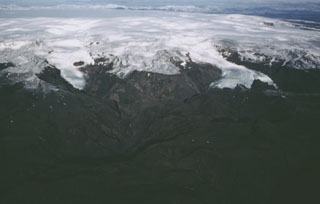Report on Katla (Iceland) — 3 May-9 May 2023
Smithsonian Institution / US Geological Survey
Weekly Volcanic Activity Report, 3 May-9 May 2023
Managing Editor: Sally Sennert.
Please cite this report as:
Global Volcanism Program, 2023. Report on Katla (Iceland) (Sennert, S, ed.). Weekly Volcanic Activity Report, 3 May-9 May 2023. Smithsonian Institution and US Geological Survey.
Katla
Iceland
63.633°N, 19.083°W; summit elev. 1490 m
All times are local (unless otherwise noted)
Iceland Met Office (IMO) reported that an intense seismic swarm began at Katla at 0941 on 4 May with three earthquakes larger than M 4 occurring beneath the caldera within about 10 minutes. The Aviation Color Code was raised to Yellow, the second lowest level on a four-color scale. According to a news article the three largest events were magnitudes 4.8, 4.7, and 4.5, adjusted from previous estimates of 4.5, 4.3, and 4.2. The larger earthquakes were felt in Thórsmörk and by residents in areas S of Mýrdalsjökull glacier (the glacier that covers Katla). The intensity of the events decreased after noon, though smaller earthquakes continued. Seismicity had decreased significantly by the next day with only five events recorded during 0000-0915 on 5 May. In an update posted at 1140 the activity was described as normal, and the Aviation Color Code was lowered to Green. More than 40 earthquakes had been recorded during the previous day and no other data indicated significant changes or anomalies. It was noted that the magnitudes were unusually large and similar to events that last occurred in 2016.
Geological Summary. Katla volcano, located near the southern end of Iceland's eastern volcanic zone, is hidden beneath the Myrdalsjökull icecap. The subglacial basaltic-to-rhyolitic volcano is one of Iceland's most active and is a frequent producer of damaging jökulhlaups, or glacier-outburst floods. A large 10 x 14 km subglacial caldera with a long axis in a NW-SE direction is up to 750 m deep. Its high point reaches 1380 m, and three major outlet glaciers have breached its rim. Although most recorded eruptions have taken place from fissures inside the caldera, the Eldgjá fissure system, which extends about 60 km to the NE from the current ice margin towards Grímsvötn volcano, has been the source of major Holocene eruptions. An eruption from the Eldgjá fissure system about 934 CE produced a voluminous lava flow of about 18 km3, one of the world's largest known Holocene lava flows. Katla has been the source of frequent subglacial basaltic explosive eruptions that have been among the largest tephra-producers in Iceland during historical time and has also produced numerous dacitic explosive eruptions during the Holocene.
Sources: Icelandic Meteorological Office (IMO), Iceland Monitor

